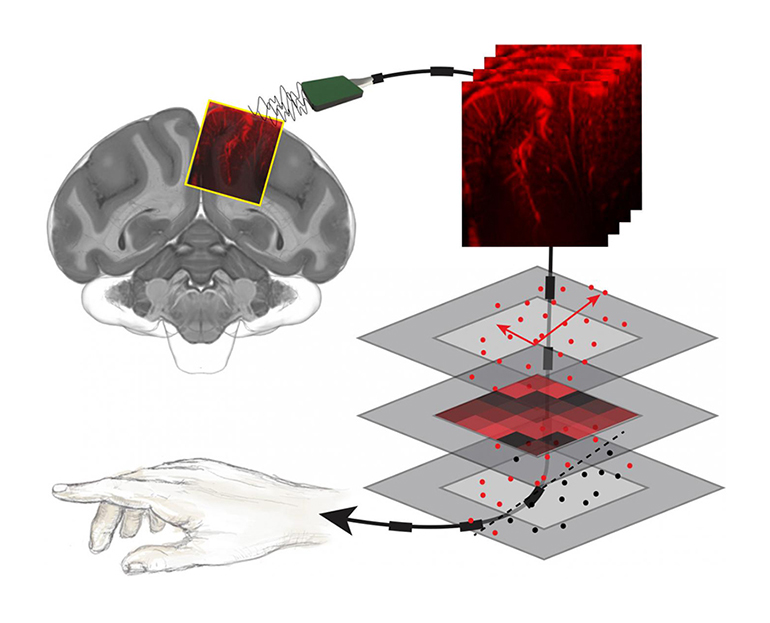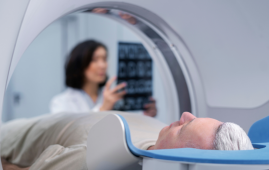

Researchers have developed a non-invasive functional ultrasound system that can detect brain activity by listening to tiny changes in blood flow within the brain. The system provides a viable alternative to invasive electrodes that are implanted into it for brain machine interfaces, such as those used in prosthetics. So far, the system can detect the activity of brain corresponding to a specific body movement in non-human primates, before the movement occurs.
Brain machine interfaces hold significant promise for those with paralysis in controlling a variety of assistive technologies, such as wheelchairs and prosthetic devices. However, the need to implant electrodes may give many pause for thought.
This latest study has shown that functional ultrasound may be a viable alternative.
“Invasive forms of brain-machine interfaces can already give movement back to those who have lost it due to neurological injury or disease,” said Sumner Norman, a researcher involved in the study, in a Caltech announcement. “Unfortunately, only a select few with the most severe paralysis are eligible and willing to have electrodes implanted into their brain.
Functional ultrasound is an incredibly exciting new method to record detailed brain activity without damaging brain tissue. We try to push the limits of ultrasound neuroimaging and were thrilled that it could predict movement. What’s most exciting is that functional ultrasound is a young technique with huge potential – this is just our first step in bringing high performance, less invasive BMI to more people.”

The new technique involves implanting a small ultrasound-transparent window in the skull (here’s an example), which is significantly less invasive than directly implanted electrodes. The ultrasound signals can then non-invasively pass into it and identify increases in blood flow in specific the regions. So far, the technology tests in its potential to help decode intentions to move in non-human primates.
“The first milestone was to show that ultrasound could capture signals related to the thought of planning a physical movement,” said David Maresca, another researcher involved in the study. “Functional ultrasound imaging manages to record these signals with 10 times more sensitivity and better resolution than functional MRI. This finding is at the core of the success of brain-machine interfacing based on functional ultrasound.”
more recommended stories
 Researcher Develops MRI Scan Error Detection Sensor
Researcher Develops MRI Scan Error Detection SensorThe world’s first sensor prototype that.
 Antioxidants: Impact on Quality of Life in Acne Vulgaris
Antioxidants: Impact on Quality of Life in Acne VulgarisA recent study published in the.
 Brain Pulsations Linked to High BMI
Brain Pulsations Linked to High BMIAccording to a new study from.
 Brain Age Estimation: EEG Advancements in Neurology
Brain Age Estimation: EEG Advancements in NeurologyTo estimate brain age using EEG.
 Retinal Neurodegeneration in Parkinson’s Disease
Retinal Neurodegeneration in Parkinson’s DiseaseBy measuring the thickness of the.
 Role of Engineered Peptides in Cancer Immunotherapy
Role of Engineered Peptides in Cancer ImmunotherapyIn a recent publication in Nature.
 Neoadjuvant Chemotherapy Boosts Ovarian Cancer
Neoadjuvant Chemotherapy Boosts Ovarian CancerDuring the COVID-19 pandemic, US women.
 Nutrient Optimization: Vitamin D for Health
Nutrient Optimization: Vitamin D for HealthResearchers addressed the prevalence of vitamin.
 AD and Headache Disorders: Recent Findings
AD and Headache Disorders: Recent FindingsAtopic dermatitis (AD) patients may be.
 Myasthenia Gravis Treatment: Eculizumab & Ravulizumab
Myasthenia Gravis Treatment: Eculizumab & RavulizumabA recent study found that myasthenia.

Leave a Comment